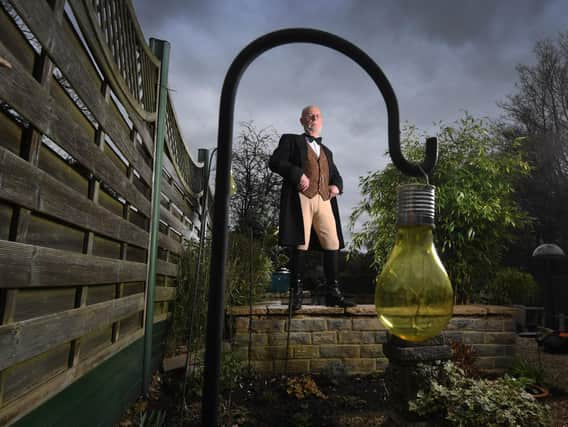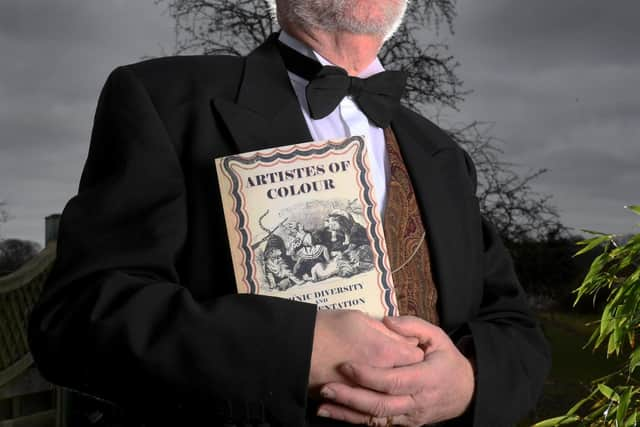Leeds circus performer and academic's new book aims to give ethnic minority contributors recognition


As children’s birthday surprises go, upstaging Coco the Clown has to be up there.
For Leeds performer Dr Steve Ward it is such a memory that sparked an association with the circus which has lasted more than 40 years and taken him around the world.
Advertisement
Hide AdAdvertisement
Hide AdIn his latest book, though, he aims to correct a history that has largely omitted the contributions of people from ethnic minorities to the art form he loves - particularly in its 19th century golden age.


The Kippax author’s Artistes of Colour: Ethnic Diversity and Representation in the Victorian Circus has now been published by Modern Vaudeville Press.
As Dr Ward puts it: “I think as circus has developed and there has become a predominantly ‘white’ art form, that we have forgotten the contribution in the cultural history in the circus that these performers made.
“I think because we don’t read about them very much and because we don’t know a lot about them...there’s this sort of continuing perception that the circus is predominantly white and that needs to be redressed.”
Advertisement
Hide AdAdvertisement
Hide AdHe can point to a number of figures, many of which had strong links to Leeds in the 1800s.
“This is my sixth book on aspects of social, cultural history in the circus and in all the research that I’ve done I kept coming across references to Black, Asian minority ethnic performers.
“But if you look at the history of the circus, if you read about it, these people are rarely mentioned.
“In Leeds, in particular we have a rich history of circus. During the Victorian period in the city centre alone there was something like eight or nine different venues used for circus...And people like Pablo Fanque is always held up as being the first ever Black circus owner in Britain and he was a regular visitor to Leeds.
Advertisement
Hide AdAdvertisement
Hide Ad“So a lot is known about him, but in fact in the same month that he set up his circus, another minority ethnic performer by the name of Joseph Hillier, he took over the running of a circus.
“But little reference is ever made to him in the history books.”
Another would be George Christoff, a British-born performer of Black heritage, who also took over the running of a circus later and but is rarely mentioned.
Dr Ward said: “There are quite a few of these BAME community performers who have been pushed to the margins of history in terms of the circus and because there are so many of them,
Advertisement
Hide AdAdvertisement
Hide AdI think we need to recognise their contribution to the development of the circus, particularly during that Victorian period, which was the golden age of the circus.”
Fanque’s connection to Leeds is particularly strong, for tragic reasons. In 1848, his circus, which would have been a wooden structure, collapsed at what was King Charles’ Croft (now The Core shopping centre).
“There was lot of mayhem, a lot of injuries, but the only fatality that night was his wife, sadly. She was buried a few days later and she’s buried up in Woodhouse cemetery,” says Dr Ward, who is 68.
“When Fanque died himself some years later he instructed that his body be returned to Leeds to lie alongside her - and they’re there today. You can go and visit the graves.”
Advertisement
Hide AdAdvertisement
Hide AdHe has been asked a number of times why he as a white man would write this book.
“Well because nobody else is,” he says.
“That’s the answer. There’s been very little research into this area and I think the more that it’s promoted it can only be a positive thing because people just do not know these things.”
It would be difficult to dispute Dr Ward’s love for and knowledge of the circus.
He trained in drama and eventually became involved in physical theatre and interested in the Commedia dell’Arte - an early form of professional theatre, originating from Italy, that was popular in Europe from the 16th to the 18th century - then slapstick, acrobatics and clowning.
Advertisement
Hide AdAdvertisement
Hide AdIn 1978 he did his first educational circus work with young children while living in Germany, before in the late 1980s running a large circus project in several Leeds schools.
He helped to found the Leeds Children’s Circus, operating out of the Roseville Centre and in 1991 gained a Winston Churchill Travelling Fellowship to look at the circus training provision in Hungary.
Dr Ward has run several International Youth Circus Festivals for Leeds City Council during the 1990s as well as forming his own youth circus group - Circus Zanni - which went on to win the top prize at the International Circus Schools Festival in Belgium in 1996.
He also established what was the National Association of Youth Circus, an umbrella organisation advocating for circus and young people, during this period.
Advertisement
Hide AdAdvertisement
Hide AdDr Ward undertook a Masters degree looking at the role of circus in education and went on to carry out Doctoral research into the social and cultural history of the circus.
In addition to directing various circus shows in Leeds and Germany, Dr Ward has also hosted in Belgium and Brazil.
Among his previous five circus works is Beneath the Big Top: A Social History of the Circus in Britain, a book he released in 2014.
As with so many like Dr Ward, it was Coco the Clown - Russian Empire-born Latvian, Nicolai Poliakoff, who in classic form ran away from home to join the circus and became famous - who first caught his imagination.
Advertisement
Hide AdAdvertisement
Hide AdThough unlike most, the Kippax man boasts that first-hand encounter.
“I was taken to the circus...as a young child as a birthday treat. During that performance, although I can’t remember much about it, into the ring came this clown. Coco the Clown.
“And he promptly plucked me from the audience and took me into the ring.
“I didn’t know whether I was scared or terrified or excited - I can’t remember - but it took me a very short time to realise: ‘Hang on a minute, all the people out there, they’re applauding me.
Advertisement
Hide AdAdvertisement
Hide AdAll the people out there, they’re laughing at me. Never mind this guy next to me - it’s me they’re applauding’.
“And I got hooked from that day on I think, and Coco the Clown was my hero for many years and that’s what heavily stirred it up originally.”
Reflecting on the nature of the art form, Dr Ward adds that Coco the Clown once said that “there is nothing new in circus, all you do is change the presentation of the same act. Juggling is still juggling, but it’s the way it’s presented.
"It develops and it embraces the society and the culture it’s in and it keeps rolling forwards. And I think circus will never really die. Circus will always be out there.”
Artistes of Colour: Ethnic Diversity and Representation in the Victorian Circus is available to buy now.
Comment Guidelines
National World encourages reader discussion on our stories. User feedback, insights and back-and-forth exchanges add a rich layer of context to reporting. Please review our Community Guidelines before commenting.